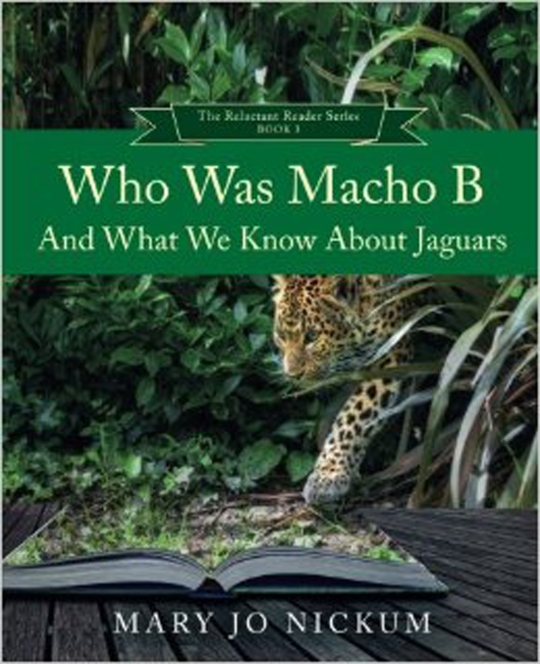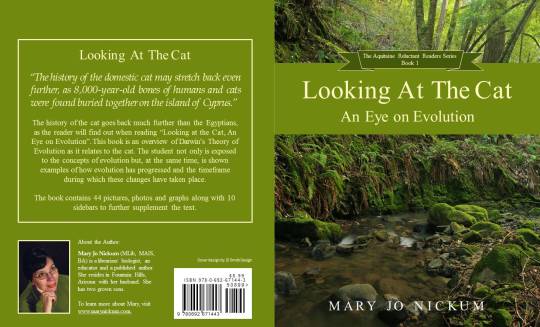Website Article
Middle school boys who are reluctant readers value reading more after using e-readers. https://reluctant-reader.net/
Middle school boys who are reluctant readers value reading more after using e-readers. https://reluctant-reader.net/
Only 6 days left to enter the Goodreads Giveaway for:
Who Was Macho B and What We Know about Jaguars

It’s no secret that science has a PR problem. Scientists, it seems, are generally viewed as cold and competent but not warm and trustworthy. According to social psychologist Susan Fiske of Princeton University, a person’s perceived warmth strongly influences how much they are trusted. This presents a problem for scientists, especially in an era when funding, research impact, and science literacy rely so heavily on communicating effectively with a broader audience. Even when seeming warm and trustworthy could help their message be heard, it can be hard for scientists to shake the “cold and competent” stereotype. The authoritative and unemotional way that scientists are taught to write for journal articles usually is not appropriate when communicating with a general audience. Learning the principles of journalistic nonfiction often requires scientist authors to step away from an academic writing style that has come to feel intuitive. Nevertheless, using these styles can make the scientist’s work more relatable, memorable, and trusted.
Here are some tips:
Those grammar classes seem like eons ago. Now we’re writers and we’re not as sure as we used to be. Years of exposure to lazy writing and editing by publishers and the media make things sound right, just because we’ve heard them over and over. As an editor, I’m offering some tidbits that I hope will help you refine your writing.
Phrase vs. Clause
A phrase is a group of grammatically related words that does not contain a main verb. T e wards in the phrase act as a unit, usually functioning as a part of speech. For example:
The girl is in school today, but tomorrow she is going to hunt. Notice that ” in school ” and “to hunt” are phrases functioning as adverbs describing a place or activity. “The girl” is a phrase in the sense that the words go together as determiner and noun, but it does not function as a part of speech.
A clause is a group of grammatically related words that does contain a main verb_
Some clauses can stand alone as complete sentences. Such clauses are called main or
independent clauses. For example: The girl is at home today, but tomorrow she is going hunting.
The two clauses in this sentence are “The girl is in school today” and “tomorrow she is going to hunt.” The joining word “but” is simply a connecting word; it does not belong to either clause. Either clause, therefore, can stand alone, expressing a complete thought:
The girl is in school today. (complete thought) Tomorrow she is going to hunt. (complete thought)
Other clauses are prevented from standing alone because they begin with words that limit their meaning, words like because and when. Such clauses are called subordinate or dependent clauses. For example: The boy quit school because he missed too many classes. “The boy quit school” is a complete thought and, therefore, a main clause. “Because he missed too many classes ” is an incomplete thought and, therefore, a subordinate clause. The “because” leaves us wondering what went before.
COMMON ERROR: A common writing fault is to separate two independent clauses with a comma (with no conjunction after it).
INCORRECT: They have a fly casting class here, the students like it.
CORRECT: They have a fly casting class here. The students like it.
or
CORRECT They have a fly casting class here, and the students like it.
What’s the Object?
As a part of the sentence, an object is a word that receives the action of an action verb. For example, in the sentence The batter hit the ball, the action of hitting has a receiver, ball. The ball receives the action and is, therefore, called the object of the verb.
There are two kinds of objects: direct and indirect. The word that receives the action of the verb is called the direct object. When the direct object is passed indirectly to another receiver, that receiver is the indirect object. For example: My sister writes me long letters.
The direct object is “letters.” The indirect object is “me.” “Letters” receives the action of writing, while “me” receives the letters. One way to tell the two objects apart is that the indirect object usually comes directly after the verb.
Another way to determine which object is which is to ask these questions about the verb:
1. “Writes” what? Answer. “letters,” so direct object.
2. “Writes” to whom or for whom? Answer: “me,” so indirect object
Some verbs that often take indirect objects are: write, send, tell, give, buy, and sell.
Interrogative Pronoun?
Standard forms of this pronoun include: what, which, who, whom, whose. These pronouns are used to introduce questions: What are the odds? Who left the gate open? Which is mine?
NOTE: The subject pronoun “who” has the object form “whom.” It is the pronoun most often misused in the media today.
The tendency for many speakers is to avoid whom altogether and use who as both subject and object. This is no longer viewed as a serious error. However, using whom where the subject form is called for is an error to be avoided at all costs. For example:
ACCEPTABLE: Who are you calling?
CORRECT Whom are you calling?
INCORRECT: Whom is coming with us to the lodge?
CORRECT Who is coming with us to the lodge?
Demonstrative Pronoun
Standard forms of this pronoun are: this, that, these, those. These pronouns are used to stand for a noun and separate it from other entities. For example:
Is this the one you wanted? land me those.
NOTE: Generally speaking, use this and these to indicate items near the speaker, and that and those for items farther away. Notice that demonstrative pronouns replace the noun. The same words – this, that, these, and those – are also used as “demonstrative determiners” or demonstrative adjectives.” For example: This woods is dark. (Here “this” is specifying the noun “woods,” telling us which woods.)
Relative Pronoun
The relative pronouns are that, who, whom, which, where, when, and why. Like other pronouns, the relative pronoun replaces a noun. Like a conjunction, it serves as a joining word
between clauses. For example:
That’s the man who shot my deer.
The word “who” is a relative pronoun. It stands for “man” and it (inks the main clause “That’s the man” to the dependent clause “who shot my deer.”
Photo captions are the most read body type in a publication. Of all the information content, only the titles of articles and abstracts have higher readership than captions. It follows that standards of accuracy, clarity, completeness and good writing are as high for captions as for other parts of the paper. As with headlines, captions must be crisp; as with articles, they must be readable and informative.
Figure Captions: Captions describe the photo or graph. Descriptions or discussion of the content of the Figure should be handled in the text of the article.
Often such sentences begin the article. In other cases, summary sentences
are preceded by one or a few sentences designed to stimulate additional
reader interest in the topic. The opening sentences are known
as the “lead.”
Leads tend to follow one of four major formats: the simple
statement, the bullet lead, the narrative lead, and the surprise
or paradox lead.
Some of these leads allow the writer considerable room
for creativity.
The Simple Statement and Bullet Leads
The first lead is a simple but dramatic statement of the major finding,
usually in a single sentence, such as a simple statement that “The Zika Virus Can be Sexually Transmitted”.
A more interesting lead, but one that is more challenging to write, is
called the Bullet Lead.
Actually, it consists of three bullets, which are always
followed by the general summary statement. For example:
• We all know people who have trained their dogs to fetch the daily
newspaper without tearing it.
• Similarly, we all know that horses can be
trained to respond to the slightest movement of their riders and
• We all know that goldfish can be trained to come to the front of the fish bowl at
the sound of a bell.
Now it turns out that even octopi (Octopus vulgarus) can be trained to perform certain simple tasks and that they actually learn those tasks more quickly from each other than from a human trainer.
If the bullets are fired successfully, by the end of the third “bullet”, the
reader is wondering how the individual bullets are related and where they
are “leading.”
Just at that moment, the skillful writer answers those
questions; if done properly, the reader wants to read more.
The Narrative Lead
The narrative lead tells a story of some sort, and then follows up with the
summary sentence:
Sitting at the bottom of a large glass tank is a 2-pound octopus. The
octopus has been trained for several weeks to avoid balls of one color
and to pick up balls of a different color. Every day for 6 hours he has
been rewarded with food for choosing the right balls, and punished
with mild electric shocks for choosing the wrong ones. Now, he sits
idly in the tank, his eyes apparently following every movement of
the researchers as they prepare to set up the next experiment,
his mantle cavity filling and emptying in a consistent respiratory
rhythm.
The researchers bring over a tank containing another octopus,
one that was freshly collected that morning from the warm and inviting
waters just outside the marine laboratory. The two octopi quickly crawl
toward each other in their respective tanks, peering through the glass
with apparent interest. “Now watch this,” one of the researchers says
to the newcomer, as she puts the trained octopus through his morning
paces. The newly collected octopus watches, and seems genuinely
interested in what the other octopus is doing. Now the researchers offer
the same choices to the new octopus. Remarkably, after watching only
four trials, the observing octopus chooses the correct ball over the other
one in every one of the trials.
The surprising finding that octopi can learn from watching
each other was recently published in the research journal Science
by two biologists working at laboratories on the Italian coast.
The Surprise or Paradox Lead
This lead tries to arouse the reader’s attention by making a surprising or
paradoxical statement then following up with the summary sentence.
For example:
Biologists, for years, have spent many tedious hours training animals
to perform simple tasks, by rewarding the desired behavior and
punishing the undesired behavior. Now, it seems at least some
animals may learn far more quickly by simply watching each other than
by being trained by humans.
Two Italian scientists, Professor Graziano Fiorito and Professor
Pietro Scotto, announced in a recent issue of the research journal
Science, that the common octopus can not only be trained to distinguish
between objects of different colors, but can in fact learn to make these
distinctions even more quickly by simply watching each other.